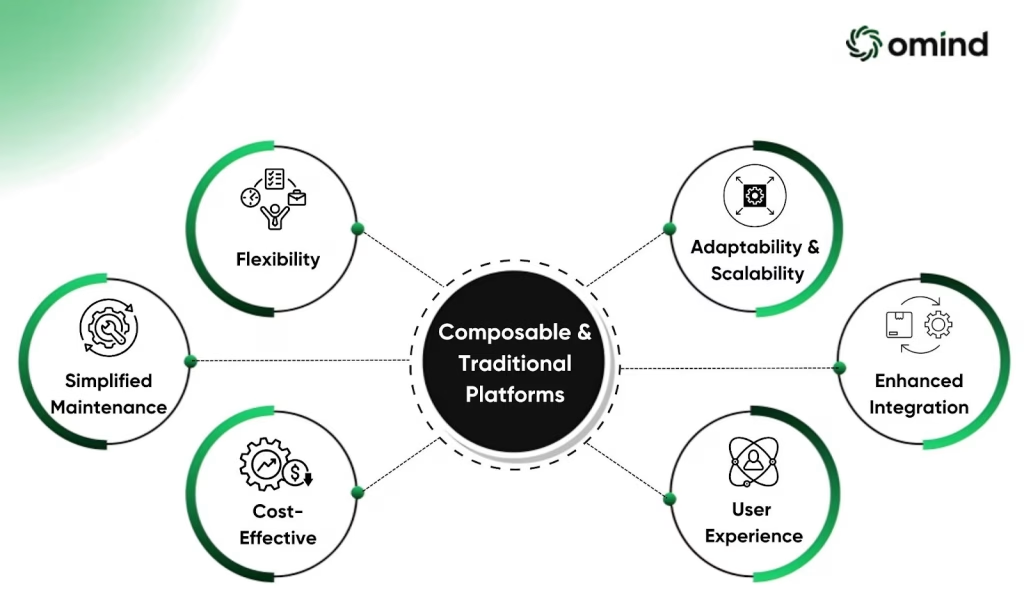Adaptability is unavoidable in this ever-changing world. A business with agility and flexibility has a higher success rate than others. So, what can you do as a businessperson? How do you manage this situation? If you leverage a composable platform that can help manage this situation, your business can offer better and personalized attention to all your customers.
Composable platforms are computer programs that allow businesses to switch out and add functions as needed. Such platforms will help an organization be flexible and meet its own needs. These platforms are significant because they offer no-code solutions. This option assists non-technical teams and IT workers make apps that fit their needs. Businesses of all sizes can benefit from composable platforms, enabling them to quickly adapt to new business needs with scalable solutions catering to non-technical and technical users.
So, you’ve got the gist of what composable platforms are all about. Let’s dive into how they can change the game for businesses, big and small.
Benefits of Composable Platforms
Giving Power to Non-technical Teams: Composable platforms ensure the team’s independence with the technology, allowing them to be creative. The non-technical technical team doesn’t want to rely more on IT teams when building and changing applications. This gives them more power, speeding up work and leading to new ideas across the organization.
Enhanced Operational Agility: These platforms help organizations in many ways, helping them to respond swiftly to market changes and demands. Being agile boosts performance and customer service.
Reduce Cost: With pre-built components and no-code/low-code tools, composable platforms reduce development costs. Organizations save time and resources by avoiding the cost of significant custom coding. Additionally, it will give you freedom when you do not want to get help from external vendors.
Increase Speed: Composable platforms speed up the process of application development and deployment. Compared to coding, they will allow the launch of new features and goods faster than ever, giving you a competitive advantage in your business.
Improved Customer Experience: Customers are like kings, and businesses must treat them well for their survival. Customers’ needs are changing, and you need to be flexible with them. Companies can personalize their offerings with composable platforms to better meet customer needs. This flexibility leads to enhanced customer happiness and loyalty.
Scalability and Flexibility: Scalability and flexibility are one of the main advantages of composable platforms. It allows businesses to expand their operations without many problems. You can integrate new functionalities with them, allowing continuous growth and evolution.
Exploring these benefits with a partner like Omind can supercharge your journey toward operational agility and enhanced customer satisfaction. Dive into how Omind leverages composable platforms for transformative solutions.
Now that we’ve unpacked the powerhouse benefits of a composable platform, how does it compare to traditional setups? Let’s peel back the layers.
Comparing Composable and Traditional Platforms

1. Flexibility
Composable platforms offer freedom in custom application development compared to traditional monolithic structures. This flexibility lets businesses tailor solutions without constraints from rigid frameworks.
2. Rapid Adaptability and Scalability
Composable platforms allow rapid adaptability and scalability to changing market needs. Businesses can quickly change their operations and scale up, ensuring they remain competitive with market trends.
3. Simplified Maintenance
The modular design of a composable platform simplifies maintenance greatly. Updating or replacing each component separately reduces downtime and maintenance costs. This modularity also makes it easier to add new features without disrupting the entire system.
4. Enhanced Integration Capabilities
Composable platforms can improve integration capabilities, allowing easy connection with other systems. These connections ensure that businesses can build an efficient ecosystem that works harmoniously.
5. Cost-Effective Upgrades
Unlike traditional platforms, where upgrades can be costly and complicated, composable platforms allow for cost-effective upgrades. Organizations can update individual modules as needed, avoiding the cost and disruption of changing an entire system.
6. Improved User Experience
Composable platforms can improve user experiences by adopting and building on user feedback. This responsiveness helps build applications that better meet user needs and expectations.
Did you get the comparison down? Perfect. Next, we’ll examine the key functionalities and features that set composable platforms apart.
Key Functionalities and Features
- When you want to add anything to traditional software, you need assistance from the IT department. However, with composable systems, you do not want to rely on them in many areas. With this, a non-technical person can do simple additional applications that reduce cost and foster operation.
- The governance approach included in these systems guarantees maintainability, compliance, and security. Businesses may use this approach to manage their apps while also following rules and norms in the sector.
- Continuous shipping cycles, feedback, and enhancement are part of composable platforms. They are relevant to the trend to help quick iteration and improvement.
- Composable platforms integrate seamlessly with existing systems, improving interoperability. This function allows companies to increase their present technological investments while acquiring new ones.
- This platform’s functions are easy to use for anyone in the organization with minimal knowledge. These user-friendly interfaces promote openness, encourage teamwork, and shorten project completion time.
- Automated workflows are vital and save human effort. Implementing automation can increase a business’s efficiency and the ability of teams. Automate and refine your digital workflows with Omind’s innovative use of generative AI, streamlining processes and enhancing team efficiency on a composable platform.
Alright, we’ve talked about what composable platforms offer. But how do they work? Brace yourself for a bit of tech magic.
How Composable Platforms Work?

- Compare Composable platforms are like LEGO blocks. It provides a foundation and tools to build complex systems with replaceable, integrative business features.
- With this approach, you can develop a library of reusable components and management processes to access and deploy them across many projects.
- These platforms come with the technology of easy integration, ensuring they function together without much infrastructure.
- A microservices architecture will break down programs into smaller, manageable services that promote independence and growth.
- APIs drive communication within composable platforms to help to communicate and interact easily. This function boosts flexibility and interoperability.
- Built-in governance frameworks ensure security, compliance, and maintainability criteria, allowing a company to manage risk and maintain control over its digital ecosystems.
- Composable platforms offer continuous integration and deployment (CI/CD) processes. Here, upgrading to the new system is easy compared to others.
- Feedback loops and iterative processes are beneficial to improve based on user feedback and changing business requirements.
Are you confident in your understanding of these platforms? Let’s get a little more technical and see what powers this innovative method can offer.
Technical Aspects of Composable Platforms
Composable systems focus on modularity and help coupling in software development. This approach allows flexibility to help you change or replace without affecting the entire system. When it comes to data security, you should give more importance. Using a composable platform aids companies in integrating different components, while robust data governance ensures data integrity and security across the platform.
Many composable platforms embrace cloud-native designs to offer scalability and efficiency, though options vary, and some platforms may use other architectures to meet specific business needs. By accepting this technology, these platforms can scale resources based on demand, which helps a lot during peak usage times. Additionally, cloud-native allows agility and resilience in this technological world.
For businesses aiming to embrace these technical aspects without hassle, partnering with Omind can provide guidance and support to ensure a successful implementation.
Are tech specs sorted? Great. Now, let’s wade into the critical waters of governance and security. It’s not about the tech but about keeping it tight and right.
Governance and Security on Composable Platforms
- Composable platforms provide building block management to control data and technology. This is helpful for companies to stay compliant with security rules and regulations. By inclining to a composable system, firms can secure their data and abide by the laws and regulations of any country.
- Automated security technologies ensure maximum productivity and a safe composable ecosystem. These solutions provide real-time alerts and automatic reactions while scanning the platform for potential vulnerabilities and threats.
- Composable platforms use a shift-left security model to prioritize data privacy laws. These security measures guarantee data privacy and help companies follow the rules and regulations. When an organization embraces a composable platform, it can reduce legal and financial risks and increase stakeholder confidence.
Navigated through the governance and security maze? Onward to peering into the crystal ball – future directions and evolving trends shaping composable platforms.
Future Directions and Evolving Trends

- Companies are using composable platforms as they help a lot in operation and reduce costs. Along with composable platforms, an organization can support exchange and cooperation that drives innovation and efficiency across the industry.
- The role of AI and ML is to automate tasks and streamline processes. These technologies allow predictive analytics, personalized recommendations, and autonomous decision-making. When you have such innovation on your side, it enhances the agility and intelligence of composable solutions.
- Cloud-native design is another future of the composable platform’s competitiveness. It offers scalability, resilience, and agility, allowing businesses to innovate and scale their operations to meet changing market demands. This, in turn, gives companies a competitive edge in the digital marketplace.
As you consider the strategic adoption of composable platforms, remember that Omind can serve as your companion, offering generative AI-driven solutions to amplify agility and innovation in your customer journeys.
As we’re cresting the wave of insights on composable platforms, let’s recap and consider how adopting these platforms can be a game-changer for your business.
Conclusion
composable platforms are a strategic asset for firms and provide agility and creativity. Their ability to adapt quickly to changing businesses helps them to accept innovation and stay competitive in dynamic markets. Even though there are advantages, continuous effort is vital to succeeding in customer experience (CX).
As we wrap up, it is sure that composable platforms influence both business and IT landscapes. These platforms transform how businesses work, reshape traditional IT, and bring success. If you need to be adaptable and agile with composable platforms, consider getting assistance from Omind. As one of the pioneers, Omind plays a crucial role in shaping the future of digital transformation at your business. Click here now to learn how our solution can drive your business forward.


